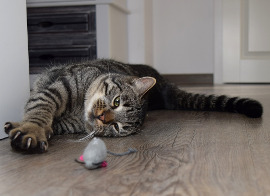 This past week, officials in the province of British Columbia announced that declawing cats will no longer be legal within the next few weeks. They will be joining Nova Scotia as the only other province in Canada to ban the practice.
This past week, officials in the province of British Columbia announced that declawing cats will no longer be legal within the next few weeks. They will be joining Nova Scotia as the only other province in Canada to ban the practice.
This ruling is based on grounds stating that declawing is inhumane, and that there are no medical or environmental reasons that justify declawing domestic house cats. And while declawing is still a common practice among today’s cat owners, many don’t fully understand what the procedure entails – and what it may do to a cat’s precious psyche.
Destructive behaviour and aggression are the biggest reasons as to why cats are declawed. Removing the claws may seem like the easiest fix, however it seldom resolves any underlying issue.
Cats need to scratch. Something. Anything. It is a natural behaviour, and providing the right channels goes a long way towards leaving household furniture intact. Cats need outlets for scratching; corrugated and carpeted scratch posts are among the most popular products.
Aggressive and unwanted behaviour can be more difficult to resolve, as the solution may not be as simple as adding a few new scratch posts into the mix. Before taking any irreversible actions, like declawing, it is wise to work towards correcting the root cause of the behaviour first.
What is Declawing?
Declawing a cat means amputation down to the last bone on each toe. This would be equivalent to removing human fingers to the last knuckle. Tendons are altered, as are nerve endings. This procedure is excessively painful, and the procedure affects most cats for the rest of their lives.
What are the Potential Side Effects?
With such a procedure, there is always the risk for complications. Physical problems include infections, and the development of abnormal, painful growths. Serious back pain after declawing is not uncommon.
Removing parts of the toes changes the shape of a cat’s foot. The result may be difficulty and pain when walking, similar to walking in a painful pair of shoes. The inability to scratch and stretch using their nails is to deny some of their most basic biological functions. This can be very stressful and may result in changes to their psyche.
Changes in a cat’s behaviour can manifest in different ways. Many will refuse to use their litter box after declawing, as it is painful to scratch and dig in litter. Most cats will stop scratching after the procedure, however many will turn to biting instead. And because cats can’t fully understand the cause of their pain, they become more aggressive.
Alternatives to Declawing
There are many products on the market designed to address and encourage proper scratching behaviour. Scratch posts and scratching toys come in a variety of shapes, sizes, and materials. There are also bitter or spicy sprays that, when sprayed on furniture, do a decent job of keeping cats away. Staying consistent with nails trimmings is your first line of defense.
If your cat suffers from severe and unexplained aggression, whether towards humans or other animals living within your home, speak with an animal behaviour specialist. They can help you determine the root cause of the aggression and formulate a plan of action. In certain cases, rehoming the cat may be necessary. Declawing is not an effective way to deal with aggression.
Declawing is still legal in Ontario, yet there is a growing swell of veterinarians removing the procedure from their services unless medically necessary.
With all that said, many declawed cats go on to live completely unaltered, albeit normal lives. However, that is not always the case, and it is worth serious consideration to determine whether declawing is not only the best thing for the household, but best for the individual cat’s quality of life.
Brandon Forder – also known as The Pet Expert – is vice-president of Canadian Pet Connection, a family-owned and -operated business located in Meaford. He has over twenty years’experience specializing in pet nutrition, behaviour, and healthy pet lifestyles. Canadian Pet Connection is an industry leader committed to providing their clients with the highest levels of personal, attentive service. Learn more at www.CanadianPetConnection.com.











